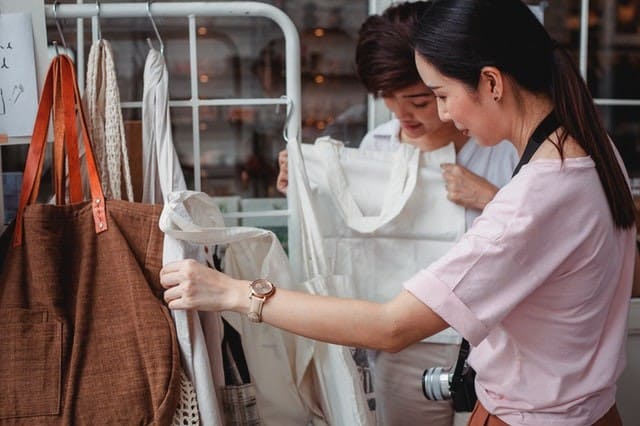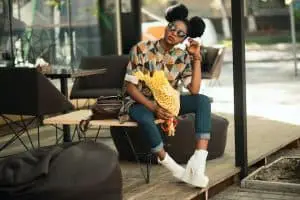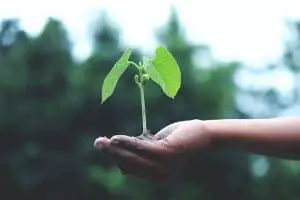Introduction
Sustainability in fashion requires a systematic approach capable of looking at a garment’s life cycle and understand how a lighter carbon footprint can be achieved by breaking down its value chain in its individual components. A product’s value chain is in fact comprised of 4 stages: product development, production, distribution and use, in order to minimise its environmental cost in each stage, sustainability practices can be implemented. In this post, we are going start focusing on the second and third stages foreseen by the Eco-Sustainable Strategy Wheel, the material sourcing stage and the manufacturing stage. In these stages, a designer or a fashion company will source the raw materials necessary to construct a product and process them into a piece of garment. Manufacturing comprises a series of industrial operations necessary to the refinement of raw materials into consumer products.
We can say that there are three areas of responsibility and accountability when it comes to environmental sustainability during these stages:
- The designer’s perspective in terms of sustainability and innovation of a collection’s design process.
- The managerial competence of developing a sustainable manufacturing and distribution process starting from the sourcing of materials to the distribution to the final consumer.
- The consumer’s responsibility in terms of product use, durability and disposal.
In this post we are going to discuss in more detail the second of the three stages of responsibility, in particular focusing on:
-
- Materials sourcing decisions that lower a firm’s environmental footprint
- Transforming fabrics into products, possible approaches to sustainable manufacturing
- Efficient and sustainable distribution strategies
- Conclusions
1. Material sourcing decisions that lower a firm’s environmental footprint
There are essentially 5 material sourcing approaches to consider in the context of sustainable fashion:
- Biodegradable Materials. These materials can be broken down into non-toxic components by natural means (e.g. using water or heat).
- Low Chemical Materials. These materials are cultivated with a minimallow chemical treatment to avoid pollution or hazardous exposure to chemical substances for labourers.
- Low Energy Use Materials. These materials require less fossil fuel energy during the production stage and reduce greenhouse gas emissions.
- Low Water Use Fibres. This approach is designed around minimal water expenditure in each stage of the product life cycle. An example of this category of products are materials such as hemp, linen and wool which do not need artificial irrigation.
- RecycledRecyclable Fabrics. In the case of recycled materials, a fashion firm uses previously disposed of, andor reprocessed materials to create new products. It’s important to notice a valuable distinction: if you are using recycled materials you are empowering your customers to make an environmentally conscious purchase. If instead, you are using recyclable materials you are still relying on your customers to follow through with environmental consciousness once a garment reaches its disposal stage.
Sourcing environmentally-conscious materials is a great way to impact a firm’s environmental footprint, however, it’s only the first step in a long journey. Let’s move on and see what options are available for sustainable manufacturing.
General sustainability principles in materials usage foresee:
- Avoiding the use of materials that could potentially damage human health
- Using renewable resources
- Using waste byproducts
- Using thoroughly tested materials
2.Transforming fabrics into products, possible approaches to sustainable manufacturing
In addressing manufacturing we need to take into account that we are discussing a very complex area of operation. Industrial-intensive processes present serious environmental challenges in terms of labour, energy and materials with serious health and environmental consequences for a wide variety of stakeholder due to chemical exposure of workers and excess waste dispersed into the environment.
Moreover, with the term manufacturing, we indicate a wide variety of processes dedicated to transforming fabrics into products. In general terms the manufacturing process comprehends three main processes:
- Dyeing Fabrics
- Cutting and Sewing Fabrics
- Assembling the Final Product
Instances of sustainability can be obtained by using streamlined knitting processes. Fashion technology companies provided a great technological leap in the process of whole-garment knitting, where no excessive fabric is used when assembling the garment with a zero-waste process.
On a more operational level, however, there are a variety of manufacturing optimisation strategies like:
- Low chemical dyeing and bleaching. In order to limit and mitigate the health impact on labourers.
- Minimise waste in manufacturing. This is a manufacturing technique in pattern cutting that maximises the amount of usable fabric per square yard while minimising waste by effectively cutting, shaping and folding fabric.
- Ethical labour. Ethical labour is a production strategy that focuses on human rights issues to achieve better working conditions and fair wages.
Once a firm has selected sustainable materials and optimised the labour process then it can move to efficient distribution strategies to alleviate the high environmental cost of distribution within its value chain.
Other basic rules for optimised manufacturing entail:
- Design to facilitate quality control
- Minimise manufacturing waster
- Minimise energy use in production
- Minimise the number of production methods
Let’s now move on to discuss sustainable distribution strategies.
3. Efficient and sustainable distribution strategies
Distribution refers to the movement of three categories of products:
- Raw materials to processing plants
- Fibres to a processing plant and manufacturing plants
- Finished products to the final consumer
The distribution stage is very taxing on the environment as 15-35% of greenhouse gas emissions come from transport. This allows companies to be creative in both packaging strategies and distribution.
Aside from packaging strategies, other efficient distribution strategies include:
- Transparent supply chains. Companies can foster honest, transparent communication between suppliersdesigners and consumers making every stage of distribution visible to the final customer.
- Efficient transport systems. Companies can invest to create an effective flow of products, not only from production to the consumer but also within its internal transport system. In this context, different transport systems have very different environmental costs: transoceanic freight ships, for instance, are more environmentally efficient than train and planes.
Other virtuous practices in the distribution are:
- Reducing product and packaging weight
- Using recyclable packaging
- Using efficient transport systems
- Using local production and assembly
4. Conclusions
By looking at this stage of the garment’s life cycle we have seen how an important segment of its life is lived under the control of industrial processes. With increasing globalisation trends more and more companies are trying to escape their own accountability in terms of environmental footprint, but those companies who are instead pursuing environmental choices are rewarded by the market.
So far we’ve seen only the part of the garment life cycle which is under the control of the firm. In this post, we’ll see what happens when the product lives its “consumer life” and how it can be disposed of at the end of its cycle. Those brands capable of earning positive reinforcements and environmentally aware associations can strive to influence consumer behaviour by promoting campaigns aimed at change the way consumers approach their daily lives and alter their own perception of ownership and use.








